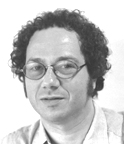
Photo: Carlos Fadon. Courtesy Julia Friedman Gallery, Chicago.
Eduardo Kac est reconnu internationalement pour ses installations interactives sur Internet et pour ses réalisations en bio art. Pionnier de l’art des télécommunications dans sa version pré-Web dans les années 1980, Eduardo Kac A (se prononce "Katz") émerge au début des années 1990 avec son approche radicale en téléprésence et en art biotélématique. Son combinaison visionnaire de la robotique et des réseaux explore la fluidité des positions des sujets dans le monde post numérique. À la fin du Xxe siècle, Kac a choqué avec son art «transgénique» . Ses travaux ont été montrés internationalement, notamment À Exit Art et, à NY, au Media Arts Center, New York; au Contemporary Art Center, Linz, Austria; InterCommunication Center (ICC), Tokyo; Chicago Art Fair and Julia Friedman Gallery, Chicago; and Museum of Modern Art, Rio de
Janeiro.
http://www.ekac.org
Eduardo Kac peut être rejoint : ekac@artic.edu.
GFP Bunny
My transgenic artwork "GFP Bunny" comprises the creation of a green fluorescent rabbit, the public dialogue generated by the project, and the social integration of the rabbit. GFP stands for green fluorescent protein. "GFP Bunny" was realized in 2000. Transgenic art, is a new art form based on the use of genetic engineering to create unique living beings. This must be done with great care, with acknowledgment of the complex issues thus raised and, above all, with a commitment to respect, nurture, and love the life thus created. As a transgenic artist, I am not interested in the creation of genetic objects, but on the invention of transgenic social subjects. In other words, what is important is the completely integrated process of creating the bunny, bringing her to society at large, and providing her with a loving, caring, and nurturing environment in which she can grow safe and healthy. This integrated process is important because it places genetic engineering in a social context in which the relationship between the private and the public spheres are negotiated. Biotechnology, the private realm of family life, and the social domain of public opinion are discussed in relation to one another. Transgenic art is not about the crafting of genetic objets d'art, either inert or imbued with vitality. Such an approach would suggest a conflation of the operational sphere of life sciences with a traditional aesthetics that privileges formal concerns, material stability, and hermeneutical isolation. Integrating the lessons of dialogical philosophy and cognitive ethology, transgenic art must promote awareness of and respect for the spiritual (mental) life of the transgenic animal.